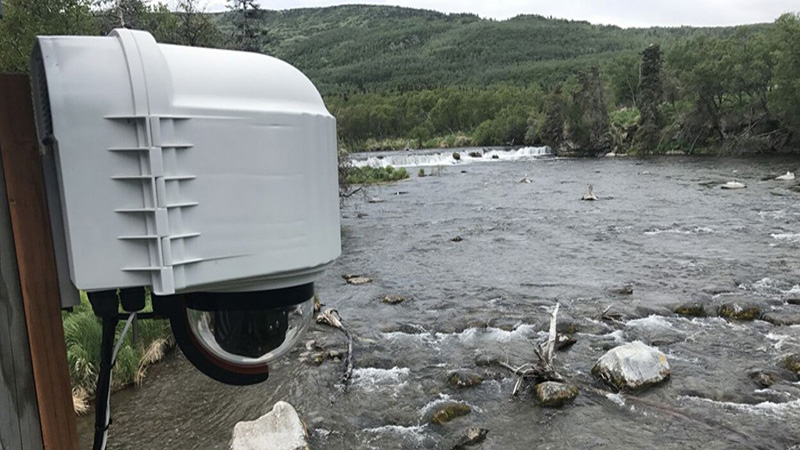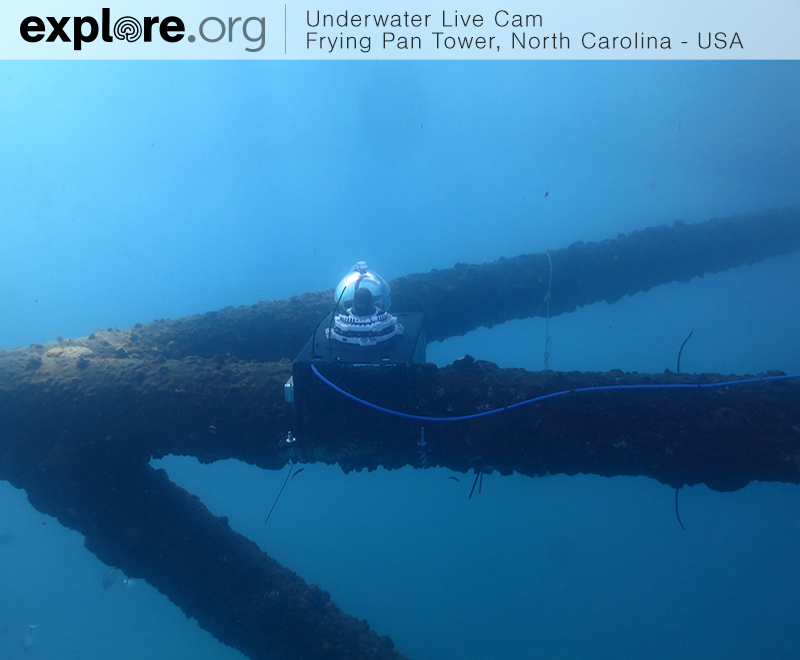From brown bears snorkeling for salmon in Alaska to hungry panda bears chomping bamboo in China, there is no shortage of activity on explore.org’s live cams. Whether you’re in the mood to watch waves break over the pristine beaches of Hawaii, a puffin chick hatch off the coast of Maine, or a watering hole in Kenya busy with hippos, elephants, baboons and giraffes, explore.org’s live cams capture and stream incredible moments in nature from all over the world. But how, exactly?
We get a lot of questions about our live cams and how they function, so we decided to give you a behind-the-scenes look at some of our most popular live cams… and a sneak peek at the sites where we’re launching totally new feeds.
But first, here are answers to some of the questions you’ve asked us most frequently about our live cams.
How big are the cameras?
The size, make, and model of our live cams depend on the location, but most of the cameras–which are weatherproof and temperature controlled–are about the size of a full backpack.
How are the live cams powered?
Similar to the size of our cameras, the way in which each camera is powered depends on the size/model of the camera, other required devices, and, of course, where it is. Our cameras use a variety of power sources. In places that receive ample sunlight, like Katmai National Park and Preserve, we use solar panels. Other cameras use fuel cells, wind generators, and even grid power.
Are the cameras really live?
Yes! Live streams are interrupted or delayed at times due to weather, power or network outages, and other factors, but when the cameras are listed as LIVE, they really are. On some cameras, live streams are scheduled based on what we know about the location, such as daylight hours, visibility, and the times we know the cameras will be most active. When a camera is offline for maintenance, to conserve power, because of a lull in activity, or because it’s the off-season, the live stream is replaced by a highlights reel of some of our favorite recent captures from that camera site.
How many cameras are there?
Explore has installed more than 130 cameras around the world, but the number of cameras running at any given time varies greatly depending on many factors, including location, season, and the amount of activity in the area at a given time.
Where are the cameras mounted?
Explore’s cameras are mounted on many different platforms–some are even underwater! Mounting locations include natural ones (like in trees or on cliff faces), existing man-made structures (like buildings, bridges, power structures, towers, or boats) or on specially designed and constructed wildlife viewing platforms. These wildlife platforms are erected in conjunction with our nonprofit partners to ensure that they are placed and constructed in ways that provide excellent views without negatively impacting the wildlife or environment.
How are the cameras operated?
Some of our cameras are programmed auto-tours, but many (including some of our most popular) are manually controlled by remote volunteer camera operators, who help ensure that the cameras are focused on the best views each location has to offer. These passionate volunteers are often people who might not otherwise have access to these remote locations–like disabled seniors or inner-city youth. Additionally, many of our operators come to us through a partnership with New Earth, an organization that mentors young men and women as they transition out of incarceration. In addition to learning how to operate remote cameras, these young people learn how to edit and produce film and use social media–skills that will help make them competitive in the job market.
How do the cameras capture audio?
Whenever possible, we try to integrate high quality, weather-protected microphones into our camera installations so we can capture stereo audio (even when it’s underwater!) and truly make viewers feel like they are being transported. In some locations, the audio must be turned off for privacy considerations, but in others, the audio can be particularly fascinating (like the African safari live cam) or soothing (like the Hawaii pipeline live cam). In other locations, our partners like the Aquarium of the Pacific will use the audio to broadcast live educational talks.
How are cameras repaired?
Because these are 24/7 cams, outages can (and do) happen at all hours. Whenever there is an issue with a live cam, our team works quickly to diagnose the problem. If the problem lies within Explore’s servers, we can repair it remotely and usually quickly. But if the issue is internet, power, or hardware-related, we turn first to our partner at the location to help us implement a solution. Occasionally, more complex repairs will require sending an engineer out to the camera site. Given the remoteness of some of our camera locations–and because some areas are only accessible at certain points during the year–repairs can sometimes take time. For instance, we can only reach our walrus cam in Round Island, Alaska, by helicopter! Plus, while our partners are eager to showcase the wildlife and landscapes they work with, their important work is their first priority, not our cams.
Don’t the cameras get dirty?
Absolutely. Fortunately, many of the cameras are equipped with self-cleaning enclosures. However, there are some situations that require a manual cleaning, which our partners help us with.
What camera are you dying to hear more about? Let us know in the comments and stay tuned for the next installment of Explore Behind the Scenes!






